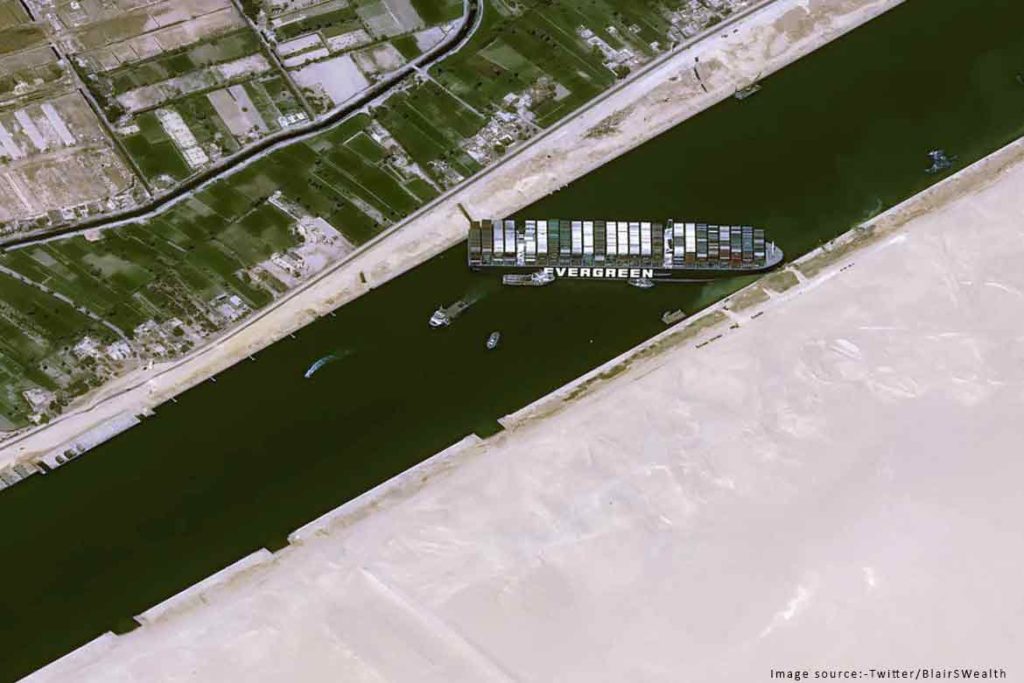The blockade of the Suez Canal opened on Monday after six days. A ship named ‘Ever Given’ has been freed in the canal. Due to the stuck ship, traffic in the canal came to rest, due to which there was a loss of about 400 million dollars. The longer closure of the canal could have caused a major setback to global trade.
What caused the blockade?
The ‘Ever Given’ ship was on its way to Port Rotterdam, the Netherlands after loading cargo from China. The ship was passing through the Suez Canal but got stuck in the canal due to the strong and dusty wind. The 400-meter long ship has more than 2 lakh tonnes of cargo. The ship was built in 2018, which is operated by a company called Evergreen Marine. Traffic in the canal came to a complete halt as the ship got stuck. About 150 ships were stranded on either end of the canal. These vessels were loaded with petroleum products and food items.
The strategic significance of this canal:
The Suez Canal is one of the busiest sea routes in the world. This canal accounts for 12% of the world’s maritime business. After the canal was built, the distance between Asia and Europe has been reduced by 6000 km. Along with this, the time taken in the journey has also decreased by about 7 days. This is the reason that passing the Suez Canal is the most profitable deal for sea traffic between Asia and Europe.

Also read: INSTC And Chabahar Port Jointly More Advantageous For India; Know How
In 2020, more than 19,000 ships were diverted from this canal. Every day about 50 ships pass through here, on which goods worth 10 billion dollars are loaded.
Vested interests of India:
India uses the Suez Canal to import and export goods from North America, South America and Europe. This includes furniture, leather goods, petroleum products, automobiles, machinery, textiles, etc. According to data from the Indian Ministry of Commerce and Industry, this business is worth about the US $ 200 million.
A brief history of this indispensable sea route:
In 1854, the French diplomat Ferdinand de Lesseps began working on a plan to build the Suez Canal. In 1858, a company was set up for it called Universal Suez Ship Canal Company. This company was tasked with the construction and operation of the canal for 99 years. The canal was completed in 1869 and opened to international traffic.
The President of Egypt Abdul Nasser nationalized the Suez Canal in 1956. Most of the shares in the Suez Canal Company were owned by the British and French government. In such a situation, the move of Nasir created a ruckus in both countries. Britain, France and Israel attacked Egypt to oust Nasser. However, due to the intervention of the United States and the United Nations, Britain and France had to withdraw their forces. Since then, the canal has been completely under Egyptian occupation.
Previous instances of such blockades:

The canal was closed for the first time on 26 July 1956. The reason was the controversy arising after the announcement of the canal’s nationalization.
In June 1967, during the six-day war, 15 ships were caught in the path of the Suez Canal amidst shelling from both sides. One of these ships sank, while the remaining 14 were imprisoned for the next eight years. Because of this, business from this canal was closed for 8 years.
In 2004, 2006 and 2017, traffic in the canal was interrupted for a few days due to shipwrecks.
